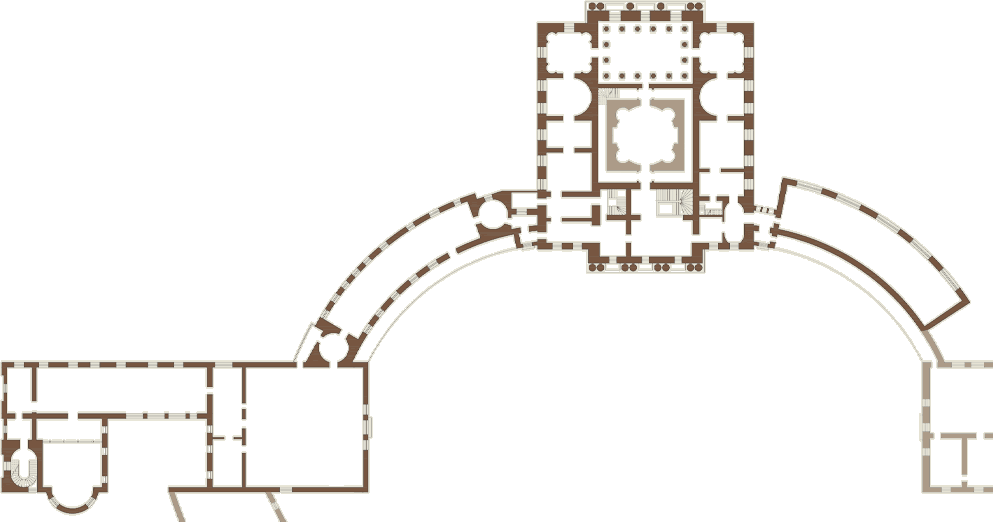The Palace Church
Загрузка панорамы...
The Palace Church was built in 1799 by the architect Vincenzo Brenna. It occupies a separate one-and-a-half-story building adjacent to the Knights Room, from which you can access the choirs of the church. The choirs, which are a loggia balcony, were intended for the owners of the palace (there was an Imperial throne chair here) and the most famous guests who entered here from the Antechurch Gallery, as the Knights Room was called officially. The church can be entered directly from Sadovaya Street through the special church entrance, up the stairs. The interior of the church is typical for religious buildings of the neoclassical era, when there a departure from the native Russian traditions in the design of churches is clear, turning to the Western European models. For instance, there is no multi-tiered iconostasis in the Palace Church, despite it being a single whole with the royal gates not only in artistic and architectural design but, above all, in artistic and semantic meaning. There are also no traditional icons in the church. In the iconostasis and on the walls, there are copies of famous works by Western European artists on evangelical motifs, with the Mother of God dominating in the compositions on the wall: The Holy Family (a copy from the work by Pompeo Battoni), Holy Night or Adoration of the Shepherds (a copy from the work by Correggio), The Ascension of the Madonna or The Immaculate Conception (a copy from the work by Bartolomé Esteban Murillo). In the upper row, in round medallions, there are images of the Holy Apostles Peter (left) and Paul (right), in whose honor this church was consecrated (copies from the works by Anthony van Dyck). The painting of the plafond contains the composition The Conversion of Saul, a key episode in the life of the Apostle Paul when he believed in Christ. This plot was not chosen by chance, since the name of the Apostle was associated with Emperor Paul I. The painting was performed by the court decorator Johann Jakob Mettenleiter, who reworked the composition of Peter Paul Rubens.
Sculpture occupies a large place in the design of the church interior, which is uncommon for Russian churches as well. On the high pylons of the iconostasis above the entrance to the altar part, there are figures of kneeling angels (sculptor Ivan Prokofiev, recreated in 1977 by N. Maltseva and T. Shabalkina). The sculptures stand in niches in the choir of the church: Faith with a Cross and a Chalice and Religion with a Book. The original author is unknown, and they were recreated in 1975–1977 by the same masters. In a round niche above the choir, there are two angels with a cross, supposedly originally made by Mikhail Kozlovsky, recreated in 1987 by T. P. Shabalkina. With all the severity of the architectural solution, the carved gilded doors of the altar gates and large carved gilded floor lamps installed on consoles along the walls give the air of a distinct solemnity. In this church, during solemn divine services in the summer of 1799, A. V. Suvorov's reports about the victories of Russian troops in Italy were read out, and on August 9 of the same year, "long life was wished to the Commander-in-Chief of the Army, Field Marshal General Prince of Italy and Russian Count Suvorov Rymniksky together with all the army". It was the first time the new title of Suvorov was heard: the Prince of Italy. The funeral service for Konstantin Konstantinovich, who died in Pavlovsk on June 2, 1915, was held here. The decoration of the church, almost entirely destroyed in the fire of the war, was recreated by 1977. All the picturesque decor, including icon paintings, was made by the restorer A. V. Treskin, the wooden carving was made by the carver V. V. Polyakin. From the original decoration of the church, the silver chandelier, lamps, and panikadilo chandeliers remained, made by the jeweler Iwar Wenfeld Buch in 1799 following the project of Matvey Kazakov, as well as the only icon in the iconostasis, The Immaculate Conception (Pyotr Drozhdin, copy of work by Bartolomé Esteban Murillo).
Currently, the church exhibits the 18th-century church utensils from the historical collection of the Pavlovsk Palace Church.
The Palace Church on the floor plane
- The Egyptian Vestibule
- The Carpet Study
- The Second Interconnecting Study
- The Main Staircase
- The Hall of War
- The Picture Gallery
- The Upper Vestibule
- The Greek Hall
- The Third Interconnecting Study
- The Italian Hall
- The Hall of Peace
- The Throne Room
- The Valet de Chambre Room of Paul I
- The Library of Empress Maria Feodorovna
- The Pantry
- The Dressing Room of Paul I
- The Boudoir
- The Orchestral Room
- The Rossi Study
- The State Bedroom
- The Knights Room
- The Rossi Library
- The Dressing Room of Maria Feodorovna
- The Chevalier Guard Room
- The Small Study of Emperor Paul I
- The Maid of Honour's Room
- The Anteroom (Turkish Room)
- The State Library of Paul I
- The First Interconnecting Study
- The Palace Church

Back
